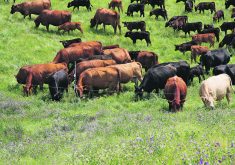Fertilizer price
The biggest response to nitrogen this year is most likely to come from farmers, rather than the crops they’re growing.
With nitrogen and phosphorus surpassing the $600 per tonne mark, Canadian farmers are inevitably going to be cutting back their fertilizer purchases.
We know that cutting back on basic plant nutrients isn’t in the best agronomic interests of the soil or the crops about to be planted, but we have to make responsible business decisions about credit, risk and cash flow.
Fifty pounds of nitrogen and 20 lb. of phosphorus will cost you $40 per acre this year. On a 5,000-acre farm, that’s a $200,000 investment.
Read Also

Budget seen as fairly solid, but worrying cracks appear
The reaction from the agriculture industry to prime minister Mark Carney’s first budget handed down November 4th has been largely positive.
Fertilizer manufacturing relies heavily on natural gas. Has anyone noticed that the price of natural gas is less than half of what it was two years ago?
We’re sitting on one of the world’s richest supplies of natural gas and potash and we’re competing with ourselves for our own fertilizer sources.
There’s nothing wrong with enjoying huge profits from the export of fertilizer to the United States and abroad, but we’re killing our ag industry here at home and the nutrient levels of our prime farmland are now even less sustainable.
– Daved Meakin,
Langham, Sask.
Marvelous millet
I can’t tell you how overjoyed I was to read your recent article about millet.
Personal research has shown that millet has high omega content also.
What’s the research basis? A very buttery taste. It may sound too simple, but flax and eggs have the same taste, although millet has it in a lesser amount.
Eggs taste the way flax does, due to high nourishment for a future chicken. That is a high omega nourishment.
Millet is a miracle food. Three quarters of the world eats millet and the Chinese eat millet and export rice due to market prices.
I’m mostly vegetarian. On occasions my friends invite me to a dinner and then say when I’m there that oops, the vegan lasagna or dish isn’t available. They try to cure me, ever sublimely. …
I love the Western Producer for writing that recent article about millet. I wake up today with the light through the almost perpetual Fernie cloud cover and think of how wonderful it is that other people also enjoy millet. Your article and that issue of the WP was very uplifting. …
I’m an orchardist in Fernie, with a year and half ag schooling with the University of Guelph. I’m slowly working my way to Creston because I love pruning also….
I’ve served a mostly European style of farm apprenticeship in Canada, then schooled briefly, just to learn. Mostly an organic farming experience. I really appreciate your article about selenium in Canadian pulses. Selenium is important for reproduction.
– Luke Gurbin,
Fernie, B.C.
Pig issues
While I empathize with both the Shepherd and Cousins families, I find it hard to not think of the discomfort the pigs must be in (“Hog review hears from producers, critics” WP, April 26).Â
If the stench emitted from hog farms is so strong that both the Shepherd and the Cousins families feel they cannot enjoy the “fresh” air, imagine how offensive the odour would be for the pigs, considering that they are cooped up in the barns and have a sense of smell much more powerful than our own.
Unfortunately, breathing ammonia-filled air is not the worst cruelty that most pigs experience on factory farms today. In Canada, around 75 percent of sows are raised in stalls consisting of a metal-barred cage with a concrete or slatted floor.
The average sow stall has only 1.2 sq. metres of space, barely enough room for pigs to stand, sit and lay down.Â
After they are about a year old, sows are generally kept in these stalls continually except for when they have piglets and are transferred to farrowing crates, or they are sent to slaughter.Â
Being kept in such confining conditions takes its toll on pigs mentally and physically, causing chronic stress, foot injuries, inflamed joints, as well as sores from rubbing on the bars.
These appalling conditions are completely unnecessary, as has been demonstrated by Sweden, the United Kingdom, Denmark, Finland, Arizona and Florida, who have all banned sow stalls. In fact, the entire European Union intends to ban sow stalls by 2013.Â
Maple Leaf Foods Inc., Canada’s largest pork producer, recently announced it will also be phasing out sow stalls.
It’s time for Canadian producers to follow these examples and get sows out of stalls.
– Kaylee Yochim,
Vancouver Humane Society,
Vancouver, B.C.
Anti-democratic?
Seven months ago, I published a letter documenting the Harper government’s deliberate actions to defeat democracy in relation to the Canadian Wheat Board issue.
Last Thursday, May 17, David Anderson, MP for Cypress Hills-Grasslands, was at it again, disrupting the business of the House of Commons agriculture committee in order to stop a motion coming forward from the NDP. The motion called for the federal auditor general to investigate the conduct and spending of the Harper government in its handling of the CWB.
But it turned out the anti-democratic methods used by Anderson were not an isolated incident.
Similar tactics were employed that same week by the Harper Conservatives in the House Official Languages Committee, the House International Trade Committee and the House Defence Committee.
The pattern quickly became clear when a 200-page secret Conservative handbook on disrupting Parliament surfaced.
The handbook, which could have been called “Defeating Democracy for Dummies,” outlined how to make sure parliamentary committees were prevented from hearing evidence from credible witnesses, and even how to shut down the committee’s work completely.
So it turns out that Anderson’s efforts to hide from the auditor general and paralyze the agriculture committee can be characterized as “just following orders.”
The Harper Conservatives’ backroom manoeuvres have now been pulled from the shadows and exposed to the hard light of public scrutiny.
As a result, more Canadians will now understand what farmers have been up against in our battle to maintain the CWB and the hundreds of millions of extra dollars we risk losing if our marketing agency is dismantled.
More importantly, more Canadians will now understand how fragile our democratic system actually is, and how important it is for us to defend it.
– Stewart Wells,
President,
National Farmers Union,
Swift Current, Sask.
MSG bad
In a recent column (WP, March 15) Dr. Clare Rowson did great harm if the WP readers believe what she wrote about MSG.
A Saskatchewan doctor, now retired, told our family that MSG is very harmful and that it destroys the lining of the stomach and a person’s taste buds.
When my sister attended Olds College, her chemistry teacher would not allow any food containing MSG in his classes. He also told his students to avoid it as it was very harmful.
The following is a quote from Dr. Hulda Regher Clark’s book Cure for All Diseases. Dr. Clark … searches out cures for the diseases instead of just treating the symptoms: “MSG, which is monosodium glutamate, should never be used in food.
“It was already banned in infant food in Europe a decade ago. Why are we still allowing it? Are our children not as precious? Healthy adults may tolerate it better than young children. But what about sick adults? Specifically, adults with a brain illness?
“Glutamic acid is a natural constituent of protein in our foods. And the sodium glutamate it must form in the body does not harm. But MSG is not biologically produced. It is lab-made. Lab-made amino acids are not the same as biologically made. Perhaps it is these isomers. Perhaps it is the simple overdose of a natural thing that is brain-toxic.
“Whatever the mechanism, MSG should not be consumed by anyone, let alone a seizure sufferer. …”
– Elaine Sloan,
Morinville, Alta.
Results overlooked
In the recent barley plebiscite, 62 percent of farmers voted for a change from the CWB’s single desk monopoly on selling barley. CWB chair Ken Ritter seems to have overlooked this point yet again.
He continues to insist that it is the role of the board of directors of the CWB to dictate policy to western Canadian grain farmers.
The CWB is an institution created by Parliament for the purpose of marketing grain on behalf of western Canadian producers.
The CWB Act does not give the board of directors authority to make policy for the grains industry. The same board should respect the will of the farmers and allow grain producers to maximize their returns directly from the market.
Mr. Ritter has been reiterating his well-worn claim that marketing choice will not work and that, by implementing it, the Harper government is acting against the will of the majority of farmers.
However, he chooses to ignore the results of the recent plebiscite. In my book, 62 percent is a majority.
Furthermore, the result of the plebiscite is in line with the CWB’s own polling.
In a poll done for the CWB by Innovative Research Group, a majority of farmers said they would prefer the option to sell to buyers other than the CWB.
A majority also felt there would be better delivery opportunities, services and prices for their barley in a marketing choice environment.
The same poll showed 75 percent of producers would prefer a plebiscite to resolve a major decision or structural change to the CWB, while only 13 percent would choose to have the elected directors decide what to do.
We are committed to providing marketing choice to western Canadian barley farmers and we are moving forward to making this a reality by Aug. 1, 2007 and want the CWB to continue as a competitive option for producers under marketing choice.
Again, I call on those CWB directors, who continue to oppose the change that a majority of farmers have requested via a plebiscite, to finally end their strife and work with us for the common good of Western Canada.
The Harper government believes the CWB’s board of directors should not stand in the way of producers finally making a profit. We promised to deliver market choice and we are keeping that promise to hard working farmers.
– Chuck Strahl,
Minister of Agriculture
and Minister for the CWB,
Ottawa, Ont.
Look for story
Attending three weeks of courses at the University of Alberta, sponsored by the Edmonton Lifelong Learners Association, was an exhilarating experience. It gave one a glimpse of the process that turns students into professionals.
But more importantly, the courses I chose broadened my view on issues that I have been interested in throughout my life.
I listened to lecturers and participated in discussions on such subjects as: human relations and religion’s part in history; the views of ancient and modern philosophers with respect to the role of human nature as it affects social and economic structure; a better understanding of the history of the Middle East; and the challenges of reversing the ecological damage brought about by technological change.
Hearing and responding to the many lectures in such a short space of time proved to be both challenging and stressful, but I would not have missed it for anything. I feel my life has been enriched. A lecturer at one of the courses made a relatively simple statement that stood out in my mind: “You should always look for the story behind the story.”
Considering the spin that we are often being exposed to, I view this advice as being especially timely.
Looking for the story behind the story used to require a lot of time poring through many books and publications. With the advent of the internet, however, the task is now much simpler.
– William Dascavich,
Edmonton, Alta.














